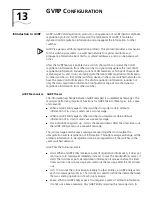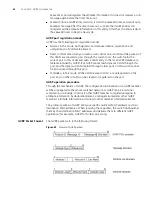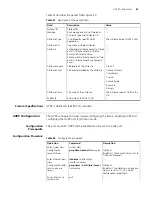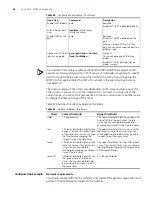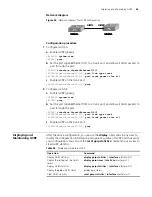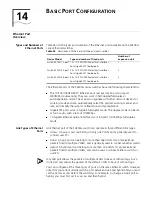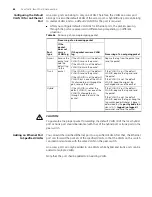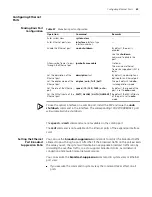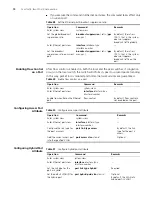
15
L
INK
A
GGREGATION
C
ONFIGURATION
Overview
Introduction to Link
Aggregation
Link aggregation means aggregating several ports together to form an aggregation
group, so as to implement outgoing/incoming load sharing among the member ports
in the group and to enhance the connection reliability.
Depending on different aggregation modes, aggregation groups fall into three types:
manual, static LACP, and dynamic LACP. Depending on whether or not load sharing is
implemented, aggregation groups can be load-sharing or non-load-sharing
aggregation groups.
For the member ports in an aggregation group, their basic configuration must be the
same. The basic configuration includes STP, QoS, VLAN, port attributes and other
associated settings.
■
STP configuration, including STP status (enabled or disabled), link attribute
(point-to-point or not), STP priority, maximum transmission speed, loop prevention
status, root protection status, edge port or not.
■
QoS configuration, including traffic limiting, priority marking, default 802.1p
priority, bandwidth assurance, congestion avoidance, traffic redirection, traffic
statistics, and so on.
■
VLAN configuration, including permitted VLANs, and default VLAN ID.
■
Port attribute configuration, including port rate, duplex mode, and link type
(Trunk, Hybrid or Access).
Introduction to LACP
The purpose of link aggregation control protocol (LACP) is to implement dynamic link
aggregation and deaggregation. This protocol is based on IEEE802.3ad and uses
LACPDUs (link aggregation control protocol data units) to interact with its peer.
After LACP is enabled on a port, LACP notifies the following information of the port
to its peer by sending LACPDUs: priority and MAC address of this system, priority,
number and operation key of the port. Upon receiving the information, the peer
compares the information with the information of other ports on the peer device to
determine the ports that can be aggregated with the receiving port. In this way, the
two parties can reach an agreement in adding/removing the port to/from a dynamic
aggregation group.
Operation Key
An operation key of an aggregation port is a configuration combination generated by
system depending on the configurations of the port (rate, duplex mode, other basic
configuration, and management key) when the port is aggregated.
1
The selected ports in a manual/static aggregation group must have the same
operation key.
2
The management key of an LACP-enable static aggregation port is equal to its
aggregation group ID.
3
The management key of an LACP-enable dynamic aggregation port is zero by default.
Summary of Contents for 4200G 12-Port
Page 10: ...8 CONTENTS...
Page 14: ...4 ABOUT THIS GUIDE...
Page 46: ...32 CHAPTER 5 LOGGING IN THROUGH WEB BASED NETWORK MANAGEMENT SYSTEM...
Page 48: ...34 CHAPTER 6 LOGGING IN THROUGH NMS...
Page 60: ...46 CHAPTER 9 VLAN CONFIGURATION...
Page 64: ...50 CHAPTER 10 MANAGEMENT VLAN CONFIGURATION...
Page 80: ...66 CHAPTER 13 GVRP CONFIGURATION...
Page 98: ...84 CHAPTER 15 LINK AGGREGATION CONFIGURATION...
Page 112: ...98 CHAPTER 18 MAC ADDRESS TABLE MANAGEMENT...
Page 126: ...112 CHAPTER 19 LOGGING IN THROUGH TELNET...
Page 162: ...148 CHAPTER 20 MSTP CONFIGURATION...
Page 274: ...260 CHAPTER 29 IGMP SNOOPING CONFIGURATION...
Page 276: ...262 CHAPTER 30 ROUTING PORT JOIN TO MULTICAST GROUP CONFIGURATION...
Page 298: ...284 CHAPTER 33 SNMP CONFIGURATION...
Page 304: ...290 CHAPTER 34 RMON CONFIGURATION...
Page 338: ...324 CHAPTER 36 SSH TERMINAL SERVICES...
Page 356: ...342 CHAPTER 38 FTP AND TFTP CONFIGURATION...
Page 365: ...Information Center Configuration Example 351 S4200G terminal logging...
Page 366: ...352 CHAPTER 39 INFORMATION CENTER...
Page 378: ...364 CHAPTER 40 BOOTROM AND HOST SOFTWARE LOADING...
Page 384: ...370 CHAPTER 41 Basic System Configuration and Debugging...
Page 388: ...374 CHAPTER 43 NETWORK CONNECTIVITY TEST...
Page 406: ...392 CHAPTER 45 CONFIGURATION OF NEWLY ADDED CLUSTER FUNCTIONS...

